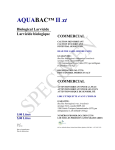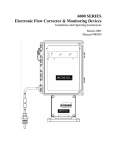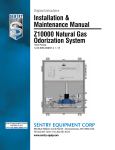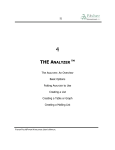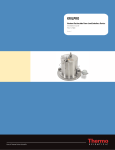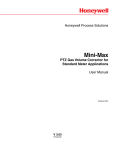Download XARTU/1 B Standard Unit Manual
Transcript
EAGLE RESEARCH CORPORATION Automation Solutions Rev 1-9-03 4036 Teays Valley Rd. ~ P.O. Box 668, Scott Depot, WV 25560 (304) 757-6565 www.eagleresearchcorp.com Table of Contents INTRODUCTION .......................................................................................................................................................1 OVERVIEW .............................................................................................................................................................1 RELIABILITY..........................................................................................................................................................1 HAZARDOUS LOCATION CLASSIFICATIONS .................................................................................................2 FOUR-YEAR WARRANTY....................................................................................................................................2 ENCLOSURE SECURITY ...........................................................................................................................................2 TECHNICAL SPECIFICATIONS ............................................................................................................................5 TERMINAL SUMMARY ...........................................................................................................................................6 XARTU/1 SOFTWARE ADDRESSING ...................................................................................................................7 INSTALLATION.........................................................................................................................................................8 UNPACKING...........................................................................................................................................................8 MOUNTING THE RTU ...........................................................................................................................................8 POWER FOR THE RTU...........................................................................................................................................9 COMMUNICATIONS ..................................................................................................................................................11 WIRING THE PULSE INPUTS......................................................................................................................................13 WIRING THE ANALOG INPUTS ..................................................................................................................................14 WIRING THE DIGITAL I/O’S .....................................................................................................................................15 OPTIONAL EQUIPMENT ......................................................................................................................................16 OPTIONAL ANALOG OUTPUT BOARD (XA-AO) ....................................................................................................16 OPTIONAL SERIAL PORT BOARD (XA-ESP).............................................................................................................18 OPTIONAL USER KEYPAD AND DISPLAY ....................................................................................................................19 GROUNDING............................................................................................................................................................20 OPERATING MODES .............................................................................................................................................21 SLEEP/WAKE-UP MODE ..........................................................................................................................................21 DISPLAY MODE .......................................................................................................................................................22 CONFIGURATION MODE ...........................................................................................................................................27 CALIBRATION MODE ...............................................................................................................................................31 ORIFICE RUN APPLICATIONS ...........................................................................................................................36 MAINTENANCE.......................................................................................................................................................39 SOFTWARE PACKAGES .......................................................................................................................................41 TALON DEVICE MANAGER AND TALON SCADA ....................................................................................................41 APPENDIX A: PARAMETER TABLES ...............................................................................................................42 TABLE A-1: PROCESS LISTING .................................................................................................................................42 APPENDIX B: XARTU/1 CONTROL DRAWING SET......................................................................................43 APPENDIX C: POSITIVE DISPLACEMENT APPLICATIONS ......................................................................51 INTRODUCTION ........................................................................................................................................................51 INDEX ASSEMBLY WIRING ......................................................................................................................................52 MOUNTING THE XARTU/1 ON THE METER .............................................................................................................53 REVERSING THE INDEX ROTATION ..........................................................................................................................54 TABLE C-1: 8-DIGIT COUNTER MASKING ...............................................................................................................55 XARTU/1 MANUAL ILLUSTRATIONS Fig. 1 – The XARTU/1 ................................................................................................................... 3 Fig. 2 – Processor Board Detail ...................................................................................................... 4 Fig. 3 – Pole Mounting Detail......................................................................................................... 9 Fig. 4 – XA-AO Analog Output Board......................................................................................... 16 Fig. 5 – XA-ESP Expansion Serial Port Board............................................................................. 18 Fig. 6 – Optional Keypad and Display.......................................................................................... 19 Fig. 7 – Using the Scroll Switch Feature ...................................................................................... 22 Fig. 8 – Typical Orifice Run Application for Gas ........................................................................ 36 Fig. 8a – DP Transmitter Wiring .................................................................................................. 37 Fig. 9 – Typical Orifice Run Application for Gas ........................................................................ 38 Fig. 9a –MVDP Transmitter Connection...................................................................................... 38 Fig. 10 - Typical Positive Displacement Application for Gas ...................................................... 51 Fig. 11 - Index Assembly Wiring ................................................................................................. 52 Fig. 12 – Reversing the Index Rotation ........................................................................................ 54 Fig. 13 – Counter Masking Kit Application ................................................................................. 56 XARTU/1 MANUAL INTRODUCTION OVERVIEW The XARTU/1 Remote Terminal Unit (RTU) is a low-cost version of the XA Series family of products. It is an intelligent, compact, rugged, and reliable industrial microprocessor-controlled computer designed for real time remote data acquisition and control applications. It can execute multiple processes including tasks such as complex math functions, control algorithms, etc., without host intervention. Flexibility, expandability, and reliability are the major factors in the XARTU/1 design philosophy. It is a balanced system, featuring flexible memory, I/O, power, and communications schemes including support for HEXASCII, MODBUS, and various other custom protocols upon request. A harsh environment tolerance is also one of the XARTU/1 strengths. The operating temperature can range from -40°C to 70°C (-40°F to 158°F), and the XARTU/1 is housed in a fiberglass NEMA 4X enclosure. This allows the RTU to exist where the work must be done, eliminating costly signal conditioning or expensive long sensor runs. The XARTU/1, normally fed with a 7-30 VDC supply, employs a low-power CMOS design. An optional 120/240 VAC unit includes an uninterruptible power supply. Should it lose power, the RTU will sense the failure, automatically switch to battery power, and continue to operate at full capacity. Other supply options include solar arrays and thermoelectric generators for sites without conventional power. The standard XARTU/1 configuration includes one modem port, two serial ports, six analog inputs, and five multi-purpose digital I/O lines. With optional modules, the XARTU/1 can be expanded to six serial ports and eight analog outputs. The optional operator interface is a two-line, 32-character liquid crystal display, and 25-key keypad with ten user-definable function keys. This allows users to examine and/or change process data and diagnose problems at the remote site without a local host or terminal. The XARTU/1 can calculate natural gas corrected volumes using AGA-3, AGA-5, AGA-7, AGA-8, and NX-19 reports, and is fully compatible with Eagle Research’s entire family of products. Eagle Research is committed to providing a complete solution for all gas flow, steam, and control applications. RELIABILITY The XARTU/1 is ruggedly built to perform in a variety of industrial environments. Care is taken to maximize reliability by applying a urethane conformal coating to all circuit boards, utilizing a hermetically sealed keypad and display, and providing NEMA 4X packaging. Page 1 XARTU/1 MANUAL HAZARDOUS LOCATION CLASSIFICATIONS The XARTU/1 is designed and approved for mounting in Class I, Division 2 hazardous area locations (refer to the NFPA Electrical Code Book). Approval for Class I, Div. 1 applications is pending. FOUR-YEAR WARRANTY Eagle Research Corporation warrants the products it manufactures to be totally free from any defects in materials and workmanship under normal operation and use. Eagle Research agrees to repair or replace any instrument that is defective due to faulty workmanship or material, if returned to our factory with shipping charges prepaid, within four years of original purchase. ENCLOSURE SECURITY Quick-release door latches that may be padlocked are standard features of the XARTU/1 to prevent unwanted users from opening the enclosure. As an option, a magnetic door-ajar switch may be installed to initiate an alarm when the unit’s door is opened. Page 2 XARTU/1 MANUAL Fig. 1 – The XARTU/1 Page 3 XARTU/1 MANUAL Fig. 2 – Processor Board Detail Page 4 XARTU/1 MANUAL TECHNICAL SPECIFICATIONS The table below lists the technical specifications for the XARTU/1 Remote Terminal Units. Features Input Power Consumption Power Monitoring Backup Battery Processor Memory Real time Clock Internal Inputs Pulse Inputs Digital I/O’s Analog Inputs RTD Inputs Communications Status LED Expansion Capability Description 7-30 VDC. Two battery inputs on MTA connectors. One power supply / rechargeable battery input on screw terminals. One solar power input on screw terminals 5 AH battery, 2-hr charging per day @ 50 mA charge rate. 1 mA average current. Less than 100 uA sleep current Supply voltage monitoring through a/d with low supply voltage Interrupt 3.6 VDC lithium backup battery: 10 years typical backup of database and time/date during normal use Phillips P51XAS3 high performance 16-bit microcontroller running at 22.1184 MHz 512K x 8 remotely-programmable FLASH program memory 512K x 8 battery-backed RAM data memory Battery-backed, quartz crystal controlled; +/- 1 sec/day typical accuracy; programmable time scheduled interrupt capability One ambient temperature input; one supply voltage input Four pulse inputs, software programmable for Form A or C; high or low speed. Each counter is a six-digit (0-999999) hardware counter with programmable interrupt support. Can be used for simple pulse accumulation, and for more complex applications such as card readers Five multi-purpose memory-mapped digital I/O lines. High-level functionality including pulse inputs, PWM (pulse width modulation) outputs, and complex custom inputs/outputs. Two I/O lines are connected to field terminals through standard OPTO-22 modules. The other three I/O lines can be used as either Form C or A relay outputs (solid state 100 mA max AC/DC) or status inputs (50 V max DC only). Six general-purpose analog inputs, 12-bit resolution, analog sampling, software calibration. Nominal input ranges 0-5.12 VDC. A 250-ohm resistor in socket allows 4-20 mA or 0-5 VDC input for each channel. Each input has three screw terminals (Supply, Signal, and Ground). Supply voltage jumper selectable to connect the switched input voltage or allow connection of an external source or 5 VDC buffered reference. Two 12-bit resolution RTD inputs; 3-wire lead compensated with ground shield connection; four screw terminals per input One modem port with extension off-hook detection. Speed up to 2400 baud. Two RS-232 ports with RX, TX, RTS, CTS, and communication switch signals. Configurable speed up to 115,200 baud. Directly interfaces to modems, radios, etc. via 6-position MTA or screw terminals. Communication protocols selectable on a per port basis. Serial ports support external communication devices such as Eagle HexASCII, Modbus, Teledyne/Geotech, and Valmet. One software-controllable LED for various function indications Additional connectors provide redundant termination points to allow for configuration flexibility. Two 10-position connectors allow for expansion over the I2C communication bus Optional isolated analog output modules and optional serial ports Page 5 XARTU/1 MANUAL TERMINAL SUMMARY Feature PULSE OUTPUTS DIGITAL I/O’s OPTO’S MODEM POWER INPUT PULSE INPUTS ANALOG INPUTS RS-232 SERIAL RTD INPUTS PHONE Page 6 Terminal XA Description 01 02 03 04 05 06 07 08 09 10 11 12 13 14 15 16 17 18 19 20 21 22 23 24 25 26 27 28 29 30 31 32 33 34 35 36 37 38 39 40 41 42 43 44 45 46 47 48 49 50 51 52 53 54 55 56 57 58 59 60 61 62 63 64 65 66 67 68 69 70 71 72 73 J-5 Normally Open #0 Common #0 Normally Closed #0 Normally Open #1 Common #1 Normally Closed #1 Normally Open #2 Common #2 Normally Closed #2 +5 VDC Digital Input #0 Digital Input #1 Digital Input #2 Ground Opto 0 (+) Opto 0 (-) Opto 1 (+) Opto 1 (-) Ground Ring Detect Off Hook Ring Tip Protective Ground Ground Ground Solar Input (7-30 VDC) Ground DC Input (7-30 VDC) Pulse 0 Low Pulse 0 Pulse 0 High + Pulse 1 Low Pulse 1 Pulse 1 High + Pulse 2 Low Pulse 2 Pulse 2 High + Pulse 3 Low Pulse 3 Pulse 3 High + Analog Power (VREF, VXD) Analog Input 0 Ground Analog Power (VREF, VXD) Analog Input 1 Ground Analog Power (VREF, VXD) Analog Input 2 Ground Analog Power (VREF, VXD) Analog Input 3 Ground Analog Power (VREF, VXD) Analog Input 4 Ground Analog Power (VREF, VXD) Analog Input 5 Ground Clear To Send Request To Send Communications Switch Receive Transmit Ground RTD 0-1 RTD 0-2A RTD 0-2B RTD GND RTD 1-1 RTD 1-2A RTD 1-2B RTD GND RJ-11 for Tip & Ring Customer Field Description XARTU/1 MANUAL XARTU/1 SOFTWARE ADDRESSING Description Terminals Software Address 1, 2, & 3 4, 5, & 6 7, 8, & 9 1.1 1.2 1.3 11 12 13 1.1 1.2 1.3 The pulse output channels are the same as the digital I/O channels. Typically, you configure each channel for either pulse output or digital I/O but not for both. The pulse output channels are the same as the digital I/O channels. Typically, you configure each channel for either pulse output or digital I/O but not for both. 15 & 16 17 & 18 19, 20, 21, 22, 23, & 24 J5 1.4 1.5 Port 0 Cannot be shared 29 J6 (VBAT1) J7 (VBAT2) 27 30, 31, & 32 33, 34, & 35 36, 37, & 38 39, 40, & 41 73.1 73.1 73.1 61.8 Form “A” 0 1 2 3 Range 7 to 30 VDC Can be read in the Extended System process with address for line power and battery at location 117 and solar at location 122 in EEPROM editor Form “C” High Speed 0.1 0.0001 1.1 1.001 2.1 2.001 3.1 3.001 42, 43, & 44 45, 46, & 47 48, 49, & 50 51, 52, & 53 54, 55, & 56 57, 58, & 59 60, 61, 62, 63, 64, & 65 0 1 2 3 4 5 Port 1 Multi-purpose port 66, 67, 68, & 69 70, 71, 72, & 73 N/A 6 7 16 73.2 73.3 RS-232 J4 (1&2) J4 (3&4) J8 CMOS J9 Pulse Outputs Pulse Output #0 Pulse Output #1 Pulse Output #2 Digital I/O’s Digital I/O #0 Digital I/O #1 Digital I/O #2 Opto Modules Opto #0 Opto #1 Modem Port Power Input Line Power Battery #1 Battery #2 Solar Pulse Inputs Pulse Input #0 Pulse Input #1 Pulse Input #2 Pulse Input #3 Analog Inputs Analog Input #0 Analog Input #1 Analog Input #2 Analog Input #3 Analog Input #4 Analog Input #5 RS-232 Serial Port RTD Inputs RTD Input #0 RTD Input #1 Box Temperature 8-Bit Analogs Notes Range –40° to 160°F Range –67° to 257°F Can be read in the Extended System process COM0 (Accessible through the military-style MS connector on left side of the unit COM1 Page 7 XARTU/1 MANUAL INSTALLATION UNPACKING 1. Thoroughly examine the box to verify it was not damaged in shipping. If you find damage, immediately file a claim with the shipper, as the manufacturer cannot be held responsible for items damaged in transportation and accepted by the customer. 2. Carefully unpack the XARTU/1 from the shipping container. Verify that the box contains every item listed on the shipping order. !!! CAUTION !!! This unit contains certain electronic components that are sensitive to electrostatic discharge (ESD); therefore, proper precautions should be taken during maintenance operations to avoid ESD. It is recommended that the operator first touch the MS connector (RS-232C port) on the left side of the unit to dissipate any accumulated static charge. Additional precautions may be taken in order to minimize the possibility of ESD, including the use of a grounding wrist or ankle strap. If these precautions are not taken and the unit is subjected to severe ESD, it may revert to its default state. However, the unit will not exhibit any loss of data or degradation of performance. 3. Open the front door by releasing the quick release latches of the enclosure and swinging the door out. 4. Examine the label on the inside right wall of the enclosure. It indicates the configuration and serial number of the RTU. MOUNTING THE RTU Note: For Positive Displacement (Index-Mounted) applications, see Appendix H on page 65. The XARTU/1 mounts directly on a wall or, optionally, on a pipe (see Fig. 3). Mounting feet are provided for wall mounting, and plates with U-bolts are provided for pole mounting. Two-inch rigid iron pipe or conduit is required for pipe mounting. It is recommended that the pipe be placed 18 to 24 inches into the ground in a 6-inch wide sackrete/concrete-filled hole. The length of the 2-inch mounting pipe or conduit will vary according to the site, but typical installations place the RTU at about eye level for ease of operation. Page 8 XARTU/1 MANUAL Fig. 3 – Pole Mounting Detail POWER FOR THE RTU Using an Internal Battery A 12.0 V, 7.8 AH alkaline battery pack supplies operating power for the RTU. If this, or any other, battery pack fails, an on-board back-up battery will power the unit's memory and real time clock. Back-up power can maintain historical data for up to ten years. When back-up power is used, the RTU discontinues normal operation until the main battery pack is replaced. An alternate source for internal power is the 12.0 V, 2.5 AH rechargeable (lead-acid) battery pack. This unit is typically used in conjunction with a local solar array. (NOTE: Units that include the optional internal keypad and display cannot be powered locally with an internal battery. An external power supply must be used) Optional Power Supplies Several optional external supplies available are: A. XAUPS series power supply - an uninterruptible 12 VDC power supply with 2.2 AH (or higher) battery backup. B. XASPS series solar system - 1 to 64 W systems available. While selected system size depends on geographic location, degree of sun exposure, equipment power consumption, and site obstructions, most RTU applications require only a 10 W system. Solar systems may be self-contained units mounted independently of the RTU, or may be simply a solar panel that charges a battery mounted within the RTU enclosure. Page 9 XARTU/1 MANUAL Wiring the Power Input WARNING The operating voltage range for the XARTU/1 is 7-30 VDC. Do NOT exceed recommended input voltage of 30 VDC. 1. a. If the unit is battery powered, check the battery pack and connect it to the J6 connector (VBAT1). Go to step 2 below. b. If the unit is solar powered with a local solar array panel, connect its output line to terminals 26 (GND) and 27 (VSOLAR+) of TB5 at the left side of the XARTI/1 processor board. In this case, a rechargeable battery pack will also be used and MUST be plugged into J6 (VBAT1). NEVER PLUG THE RECHARGEABLE BATTERY PACK INTO J7 (VBAT2) AS DAMAGE MAY RESULT. c. If the unit is AC powered, disconnect the main AC source and connect the AC line to the L1 (hot), L2 (neutral), and EGND terminals of the chosen UPS, then reconnect the main AC source. Connect the negative and positive voltage signal wires respectively to terminals 28 (GND) and 29 (VBAT1) of TB5 at the left side of the XARTU/1 processor board. 2. When power is first applied, the optional inside display will briefly show the program version, followed by the first assigned label. The red health LED will also turn on and start to flash. Each LED flash indicates the time it takes the processor to complete one scan of the database. NOTE A flashing outside display indicates an alarm condition (e.g. First Time Power). 3. When the outside display option is present, you can now view selected parameter values by using the scroll switch. The scroll switch is activated by the use of a magnet (one is shipped with the unit). See page 22 for information about this function. 4. You can also change parameter values, view, or acknowledge active alarms using the display and keypad. See information on these functions starting on page 21. The table below shows the terminal wiring for power input. Power Input Description Power Input GND (ground) GND (ground) VSOLAR (solar power) GND (ground) VBAT1 Page 10 XARTU/1 Terminal Location TB5 25 26 27 28 29 XARTU/1 MANUAL COMMUNICATIONS To communicate with the XARTU/1, the Site ID in the device must be the same as the Site ID entered in the software package. The Site ID is a unique identification number (1 to 65,535) that allows the software packages to communicate with the XARTU/1. The default Site ID number is 1. Site ID Changer, available through Talon Device Manager or Talon SCADA, can be used to enter a number other than the default. Refer to the respective software User’s Manual for additional information on these and other functions. The display and keypad can also be used to change the Site ID from its default value. In its standard configuration, the XARTU/1 is equipped with two communications ports – 0 and 1. Port #0 can be configured to allow communication through a modem or RS-232C. Port #1 can be configured for CMOS or RS-232C. An optional RS-232C serial cable is required for local direct communications. Contact your factory representative for ordering information. Modem/RS-232C Communications Port #0 (up to 2400 Baud/Modem and 57,600/RS-232) The internal 2400 Hayes-compatible modem offers automatic answering and dialing. It supports Bell 212A (1200 bps), Bell 103 (300 bps), CCITT V.22 bis (2400 bps), and V.22 (1200 bps). The modem communicates at 2400/1200/300 baud. The modem by itself can only be used in areas classified as non-hazardous or Class I, Division 2. To maintain the XARTU/1’s intrinsic safety classification in more hazardous areas such as Class I, Division 1, an optional Phone Line Interface (PLI) must be used. This device removes the high voltage ring-detect circuitry from the XARTU/1 and brings low-level signals into the hazardous area through intrinsic safety barriers. The RS-232C serial port supports RX, TX, CTS, RTS, communication switch, and ground signal lines. The J8 6-position MTA connector provides connection for the RS-232 port #0 at a default baud rate of 9,600. CMOS/RS-232C Communications Port #1 (up to 115,200 Baud) Port #1 provides a choice of CMOS-level or RS-232C communications connections. Contact your factory representative for more information on this port. Optional expansion serial port modules can provide four additional serial ports for a total of six. The serial ports may be configured for speeds up to 115,200 baud. NOTE Port #0 is dedicated to the modem. Port #1 must be used to flash the unit at 115,200 baud. Page 11 XARTU/1 MANUAL The tables below show the terminal wiring for the two communications ports. PORT #0 Modem (CMSW pin open) GND (ground) RD (ring detect) OH (off hook) RING (ring) TIP (tip) PROT GND (protective ground) RS-232C (CMSW pin grounded) CTS 0 (clear to send) RTS 0 (request to send) CMSW 0 (communications switch) Rx 0 (receive) Tx 0 (transmit) GND 0 (ground) XARTU/1 Terminal / Pin Locations TB4 19 20 21 22 23 24 J8 1 2 3 4 5 6 PORT #1 CMOS (CMSW pin open) CTS 1 (clear to send) RTS 1 (request to send) CMSW 1 (communications switch) Rx 1 (receive) Tx 1 (transmit) GND 1 (ground) Vin RS-232 Port 1 Ext. Power Control R-232C (CMSW pin grounded) CTS 1 (clear to send) RTS 1 (request to send) CMSW 1 (communication switch) Rx 1 (receive) Tx 1 (transmit) GND 1 (ground) XARTU/1 Terminal / Pin Locations J9 1 2 3 4 5 6 7 8 TB8 60 61 62 63 64 65 Page 12 XARTU/1 MANUAL WIRING THE PULSE INPUTS The standard XARTU/1 configuration includes four pulse inputs that are software programmable for Form A or C, and high speed or low speed. These inputs can be used for simple pulse counters, or in more demanding applications such as card readers. The table below shows the terminal wiring for the pulse inputs. Pulse Input Description Pulse 0 Low 0 Pulse 0 High 0 (no connection for Form A) Pulse 1 Low 1 Pulse 1 High 1 (no connection for Form A) Pulse 2 Low 2 Pulse 2 High 2 (no connection for Form A) Pulse 3 Low 3 Pulse 3 High 3 (no connection for Form A) XARTU/1 Terminal Location TB6 30 31 32 (no connection for Form A) 33 34 35 (no connection for Form A) 36 37 38 (no connection for Form A) 39 40 41 (no connection for Form A) Page 13 XARTU/1 MANUAL WIRING THE ANALOG INPUTS The standard XARTU/1 configuration includes six general-purpose, 4-20 mA or 0-5.12 VDC analog inputs and two RTD inputs with 3-wire lead compensation and ground shield connection. These are 12bit resolution inputs with analog sampling capability. In addition, there is a box temperature and supply voltage input. All analog inputs can be software calibrated. Jumpers JP5 & JP6 determine the power input to the transmitters. They provide supply voltage (7-30 VDC) when in the down position (VXD), and reference voltage (5.12 VDC) when in the up position (VREF). JP5 governs AI0 & AI2 of TB7, and JP6 governs AI1, AI3, AI4, & AI5. An external supply can also be connected to channels used when the jumper is removed. The table below shows the terminal wiring for the analog inputs. Analog Input Description Analog 0 Power 0 Analog Input 0 Ground 0 (no connection for 4-20 mA input) Analog 1 Power 1 Analog Input 1 Ground 1 (no connection for 4-20 mA input) Analog 2 Power 2 Analog Input 2 Ground 2 (no connection for 4-20 mA input) Analog 3 Power 3 Analog Input 3 Ground 3 (no connection for 4-20 mA input) Analog 4 Power 4 Analog Input 4 Ground 4 (no connection for 4-20 mA input) Analog 5 Power 5 Analog Input 5 Ground 5 (no connection for 4-20 mA input) Analog 6 (RTD #0) 0-1 0-2A 0-2B GND Analog 7 (RTD #1) 1-1 1-2A 1-2B GND Page 14 XARTU/1 Terminal Location TB7 42 43 44 (no connection for 4-20 mA input) TB7 45 46 47 (no connection for 4-20 mA input) TB7 48 49 50 (no connection for 4-20 mA input) TB7 51 52 53 (no connection for 4-20 mA input) TB7 54 55 56 (no connection for 4-20 mA input) TB7 57 58 59 (no connection for 4-20 mA input) TB9 66 67 (jumper 67 to 68 for 2-wire connection) 68 69 TB9 70 71 (jumper 71 to 72 for 2-wire connection) 72 73 XARTU/1 MANUAL WIRING THE DIGITAL I/O’S The XARTU/1 comes standard with five multi-purpose, memory-mapped, digital I/O lines. They can be programmed as either inputs or outputs. Digital outputs can be configured as simple discrete outputs, or as precisely timed pulse outputs. Two I/O lines are connected to field terminals through standard OPTO-22 modules. The other three I/O lines can be used as either Form A or Form C relay outputs (solid state 100mA max AC/DC) or status inputs (50 V max DC only). Digital I/O Description Pulse Out 0 Normally Open 0 (NO0) Common 0 (Com0) Normally Closed 0 (NC0) Pulse Out 1 Normally Open 1 (NO1) Common 1 (Com1) Normally Closed 1 (NC1) Pulse Out 2 Normally Open 2 (NO2) Common 2 (Com2) Normally Closed 2 (NC2) Digital Inputs +5V Digital In 0 (DI0) Digital In 1 (DI1) Digital In 2 (DI2) GND XARTU/1 Terminal Location TB1 1 2 3 TB1 4 5 6 TB1 7 8 9 TB2 10 11 12 13 14 The two opto module slots (OPTO1 & OPTO2) can be used as inputs or outputs. The table below shows the wiring for the two opto module slots. Opto Module Slots Description Opto 0 High-Level Module 0 (+) High-Level Module 0 (-) Opto 1 High-Level Module 1 (+) High-Level Module 1 (-) XARTU/1 Terminal Location TB3 15 16 TB3 17 18 Page 15 XARTU/1 MANUAL OPTIONAL EQUIPMENT The standard XARTU/1 is configured to handle the majority of instrument and measurement applications. However, the two 10-position header connectors located in the upper left-hand corner of the XARTU/1 Processor Board allow for expansion over the I2C communications bus. The optional isolated analog output (XA-AO) and serial port (XA-ESP) boards use this expansion feature. OPTIONAL ANALOG OUTPUT BOARD (XA-AO) The XA-AO Analog Output Board and connecting cable provides a two-channel, two-wire, looppowered, optically isolated, precision 4-20mA output. This module interfaces with the XARTU/1 to provide 4-20mA outputs for flow rate, pressure, or numerous other controls and monitoring applications. Typically, one XA-AO board is mounted internally. But a maximum of eight can be externally mounted and controlled by the XARTU/1. For this purpose, the AO board has its own custom enclosure for surface mounting. Power for the digital interface section of the AO is selectable by using the DIP switches, and can be supplied by Vcc of the XARTU/1, or from the main supply voltage. The AO board interfaces to the XARTU/1 series product via the standard I2C serial interface bus. The XARTU/1 unit requests the desired mA output from the AO board using this bus. An I2C digital I/O chip is used to send the information to the analog output section of the AO board. The analog output section of the board derives its power from the current loop, and is optically isolated from the digital control interface section. The analog output section receives commands from the digital I/O chip through opto-isolators. Commands are in the form of a serial data stream. The AO board provides 4-20mA output signals with a resolution of 1 part in 65536 (16 bit), or 0.00024mA. The D/A also allows for over-ranging of the output to a minimum of 3.5mA and a maximum of 24mA. The field interface to the D/A is a simple two-wire connection. Reverse polarity protection is provided. The XA-AO will function properly in temperatures from –40°F to +160°F, and in conditions of high humidity (including condensing environments). Software calibration of the 4-20 mA output is provided for easy calibration. Fig. 4 – XA-AO Analog Output Board Page 16 XARTU/1 MANUAL XA Analog Output Specifications Description Environmental Operating Temperature Operating Humidity Electrical Isolation Current Loop Output Maximum Output Current Minimum Output Current Maximum Supply Voltage Minimum Supply Voltage Resolution Full Scale %Error (software calibrated at 4 and 20 mA and tested at room temperature) Temperature Drift Error caused by RFI Digital Control Interface Vcc Powered Input Current Vin Powered Input Current Communications Interface Physical Width with mounting tabs Width without mounting tabs Height Depth Specifications -40°F to +160°F 0 to 100% 500 V DC or AC RMS (sine wave) between digital interface and 4-20 mA loop 24mA 3.5mA 50V 8V 16 bits, 0.00024 mA ±0.01% max ±0.00044 mA/°F max <1% of span shift with 2.8W 150MHz applied at 1.7’ 10 uA max in idle mode; 15 mA max during communications 30 uA higher than with Vcc power typical I2C as described for the Phillips PCF8575 digital I/O chip 4.75” 3.78” 2.143” 0.688” Wiring the Analog Output Loop The external wiring to the AO board is very simple. A ribbon cable connects the AO board to the XARTU/1. Commands are sent to the board via the cable by the XARTU/1 device. The 420mA current loops are simple two-wire connections. +24 VDC nominal is connected to the “+” terminal, and the “-”, or return terminal, is connected to the field instrument to which the 420mA signal is being sent. Page 17 XARTU/1 MANUAL OPTIONAL SERIAL PORT BOARD (XA-ESP) The XA-ESP Expansion Serial Port board provides an additional serial port to communicate with the XARTU/1. Up four additional XA-ESP boards may be connected to the XARTU/1. Combined with the two onboard ports, a total of six is possible. Like the XA-AO board described earlier, this board may be externally surface mounted in its own enclosure. Fig. 5 – XA-ESP Expansion Serial Port Board Page 18 XARTU/1 MANUAL OPTIONAL USER KEYPAD AND DISPLAY Another useful option to the XARTU/1 is a factory mounted keypad and display. The keypad and display may be used to access, change, and view programming data and stored information while on site. The display feature may be internally and/or externally mounted. When external, the display alone may be viewed from outside the unit without opening the door. When internal, the display is combined with an interactive keypad (see Fig. 6 below). Use of the keypad and display will be discussed in detail in the section on OPERATING MODES. Handheld Keypad and Display For units without the factory mounted keypad and display option, a rugged, portable keypad and display may be plugged in to the unit’s processor board and used just like the factory-mounted model. Contact your sales representative for more information on this option. Fig. 6 – Optional Keypad and Display Page 19 XARTU/1 MANUAL GROUNDING Because of the potential for equipment damage and injury to personnel, certain practices should, and often must, be observed when installing RTU systems. Of these practices, proper grounding is possibly the single most important. This section was included to point out general rules and practices, and NOT to supersede those defined in the National Electrical Code (NEC) published by the National Fire Protection Association (NFPA), nor the Classification of Gas Utility Areas for Electrical Installations booklet published by the American Gas Association (AGA). A sound understanding of Federal, State, and Local laws is fundamental to proper and legal installation work. Eagle Research Corporation makes no warranties or guarantees on the effectiveness or safety of any technique or suggestion here described. All RTU, electronic utility interface, and gas meter equipment should be kept at the same ground potential so that unexpected voltages anywhere on the system are quickly shunted away to earth. This calls for a common ground rod (or "bed" of grounding materials) to which is securely tied all equipment chassis, metal cabinets, and intrinsic safety ground brackets. For equipment chassis and metal cabinets, a solid copper ground wire or ground strapping of an approved size and type is recommended to tie this equipment to the rod(s). For Intrinsic Safety systems it is recommended that two #12 AWG wires be run in parallel from individual ground terminals on each I.S. ground frame. Where more than one rod is used, as when some distance separates equipment, all rods should be bonded together with copper in an approved manner. References ¾ National Electrical Code Article 250 - Grounding Articles 500 & 501 - Hazardous (Classified) Locations Article 504 - Intrinsically Safe Systems ¾ The IAEI Soares' Book on Grounding ¾ PolyPhaser Corp.'98 catalog of Lightning/EMP & Grounding Solution Page 20 XARTU/1 MANUAL OPERATING MODES The RTU operates in any of the following five standard modes: ¾ ¾ ¾ ¾ ¾ Sleep/Wake-up Display Alarm Configuration Calibration To access any operating mode, press the keypad key that corresponds to the mode you want: conf alrm cal esc for configuration mode for alarm mode for calibration mode to return to a previous mode from any other mode SLEEP/WAKE-UP MODE In normal operation the XARTU/1 maintains a powered down state (sleep mode) to conserve battery life. In this state the internal display is blank while the outside display shows the first label, CV XXXXXXXX for example, where XXXXXXXX is the most recent reading prior to the next wake-up interval. The unit executes processes depending upon the user's programmed wake-up interval. Shorter intervals result in more frequent data while longer intervals provide for longer battery life. The scheduled wake-ups result in immediate power-down after performing calculations. In addition to the scheduled wake-ups for volumetric calculations, the XARTU/1 can be brought up from its sleep mode by any of the following: ¾ ¾ ¾ ¾ Connecting a portable computer to the unit's serial communication port (MS connector) Pressing any key on the keypad Scrolling the external display with a magnet (see page 22) Calling the unit via modem Once the unit is awake, it will automatically power down one minute after the operator stops interacting with it. The RTU can also be forced to enter the sleep mode by pressing the ent and zero keys simultaneously. NOTE The XARTU/1 will not go to sleep if the RS-232C serial cable is connected. Battery life, in this situation, may be drastically reduced. Typically, the RTU remains fully awake and does not enter the sleep mode if it is powered with an external power supply. In this case, the Wake-up Interval parameter is set to 0. Page 21 XARTU/1 MANUAL DISPLAY MODE In display mode only limited parameters with assigned labels and function keys can be viewed. With the optional keypad and display, the ↑ and ↓ arrow keys will allow you to scroll through the display parameter list. You may use the jump key to directly view any of the assigned labels; press jump then enter the label number 1-64, followed by pressing ent. You can use the function keys (F0 - F9) to view previously assigned parameters. Talon Device Manager or Talon SCADA software can be used to assign function keys and labels to any parameter. Also, the local keypad may be used to assign function keys. Using the Scroll Switch On units that feature the external display, a magnet may be used to easily access information without opening the door. Just below the display window, either on the left or right, is a routed indention in the door. When the key chain magnet, supplied with these units, is held in the proximity of this ‘dimple’, the display will vary its information. Each subsequent pass of the magnet over this dimple will produce a new parameter display. When in an alarm condition, the external display will be flashing. To clear alarms, hold the magnet against the dimple until flashing stops. Fig. 7 – Using the Scroll Switch Feature Page 22 XARTU/1 MANUAL ALARM MODE The XARTU/1 can be configured to activate an alarm when certain conditions are met or when user-defined limits are exceeded. Active alarm messages can be configured to show on the RTU's display. The unit can also automatically call a host computer running Meter Reader, pcGas Host, or Pantheon software to report the alarm. A history log is kept in the RTU on each alarm condition, consisting of the following: ¾ ¾ ¾ ¾ ¾ ¾ ¾ ¾ Current value Type of alarm (high, low, etc.) Setpoint value (alarm limit) Time of alarm Date of alarm Time out of alarm Date out of alarm Extreme value alarm The RTU can be configured to monitor and alarm on any condition including, but not limited to, the following: ¾ ¾ ¾ ¾ ¾ ¾ ¾ ¾ ¾ ¾ First Time Power AC Power Failure Low Supply Volts High and Low Flow Rate High and Low Pressure High and Low Differential Pressure High and Low Temperature Current Day Flow (Transportation Limit) Low Voltage Shutdown Box intrusion NOTE Additional hardware equipment and configuration may be required for some alarm monitoring applications. Viewing and Clearing Alarms from the Keypad To enter alarm mode, press the alrm key on the optional keypad. In alarm mode you can view and acknowledge any alarm. If alarms are active, the unit will display the first alarm message. If there are more alarms, you can view them by pressing the ↓ key. Repeatedly pressing the ↓ key cycles through the active alarm list. Alarms can be locally acknowledged at the RTU by pressing the ent key while a particular alarm message is displayed, or by polling with Talon Device Manager or Talon SCADA software. Page 23 XARTU/1 MANUAL When in an alarm condition, the optional external display will be flashing. To clear alarms, hold the magnet against the dimple until flashing stops (see page 22). Unless the parameter's limits are violated again, the unit will not include acknowledged alarms in its list the next time the user enters alarm mode. To exit alarm mode without acknowledging the alarm, simply press the esc key. First Time Power Alarm First Time Power alarm is defined as the re-application of power after interruption of the power source. For example, whenever the battery is disconnected and then subsequently reconnected, the unit records the First Time Power event. Low Supply Volts Alarms If the supply voltage to the unit falls below the Low Supply Volts Alarm Setpoint value, a Low Supply Volts alarm will be initiated. The alarm will remain active until the supply voltage is greater than the Low Supply Volts Alarm Reset parameter. The setpoints are user configurable with default values of 8.5 and 8.8 volts respectively for battery powered units (see the Appendix Tables starting on page 43 for parameter addressing for your device). High Flow Rate Alarm If the flow rate should exceed the High Flow Rate Alarm Setpoint, a High Flow Rate alarm will be initiated. The alarm will remain active until the flow rate falls below the High Flow Rate Reset parameter value. The setpoints are user configurable with default values of 100000 and 99990 respectively (see the Appendix Tables starting on page 43 for parameter addressing for your device). Low Flow Rate Alarm If the flow rate should fall below the Low Flow Rate Alarm Setpoint, a Low Flow Rate alarm will be initiated. The alarm will remain active until the flow rate rises above the Low Flow Rate Reset parameter value. The setpoints are user configurable with default values of -100 and -80 respectively (see the Appendix Tables starting on page 43 for parameter addressing for your device). High Pressure Alarm If the gas pressure should exceed the High Pressure Alarm Setpoint, a High Pressure alarm will be initiated. The alarm will remain active until the pressure falls below the High Pressure Reset parameter value. The setpoints are user configurable with default values of 1500 and 1480 respectively (see the Appendix Tables starting on page 43 for parameter addressing for your device). Low Pressure Alarm If the gas pressure should fall below the Low Pressure Alarm Setpoint, a Low Pressure alarm will be initiated. The alarm will remain active until the pressure rises above the Low Pressure Reset parameter value. The setpoints are user configurable with default values of -100 and -80 respectively (see the Appendix Tables starting on page 43 for parameter addressing for your device). Page 24 XARTU/1 MANUAL High Differential Pressure Alarm If the differential pressure should exceed the High Differential Pressure Alarm Setpoint, a High Differential Pressure alarm will be initiated. The alarm will remain active until the differential pressure falls below the High Differential Pressure Reset parameter value. The setpoints are user configurable with default values of 1500 and 1480 respectively (see the Appendix Tables starting on page 43 for parameter addressing for your device). Low Differential Pressure Alarm If the differential pressure should fall below the Low Differential Pressure Alarm Setpoint, a Low Differential Pressure alarm will be initiated. The alarm will remain active until the differential pressure rises above the Low Differential Pressure Reset parameter value. The setpoints are user configurable with default values of -100 and -80 respectively (see the Appendix Tables on page 43 for parameter addressing for your device). High Temperature Alarm If the gas flow temperature should exceed the High Temperature Alarm Setpoint, a High Temperature alarm will be initiated. The alarm will remain active until the temperature falls below the High Temperature Reset parameter value. The setpoints are user configurable with default values of 200 and 180 respectively (see the Appendix Tables starting on page 43 for parameter addressing for your device). Low Temperature Alarm If the gas flow temperature should fall below the Low Temperature Alarm Setpoint, a Low Temperature alarm will be initiated. The alarm will remain active until the temperature rises above the Low Temperature Reset parameter value. The setpoints are user configurable with default values of -100 and -80 respectively (see the Appendix Tables starting on page 43 for parameter addressing for your device). Current Day Flow Alarm (Transportation Limit) If the current day's total volume should exceed the Current Day High Volume Alarm Setpoint, a Current Day Flow alarm will be initiated. The alarm will remain active until the value for the current day volume is reset the next day at roll time. The setpoints are user configurable with default values of 100000 and 99990 respectively (see the Appendix Tables starting on page 43 for parameter addressing for your device). For transport or interruptible customers, this parameter can be used to alarm when an account has exceeded a predetermined daily volume allocation. Low Voltage Shutdown Alarm If the supply voltage should fall to approximately 6.0 volts, an interrupt will be triggered and the unit will enter Low Voltage (Critical) Shutdown mode. Low Batt will be displayed on the display. This is an indication that the supply voltage is absolutely too low to operate the unit properly. The battery must be changed at this point or adequate supply voltage applied. In this mode, all operation ceased, and the unit operates in a protective mode. The on-board battery will continue to protect the unit's memory; therefore data prior to entering this mode will be maintained. The supply voltage is monitored constantly and the unit will reset itself should the supply voltage becomes greater than 6.0 volts. If the unit is left alone without applying adequate supply voltage, the battery will continue to drain and the outside display will eventually go Page 25 XARTU/1 MANUAL blank. When sufficient supply voltage is applied and the unit is powered up, a Low Voltage Shutdown alarm will be recorded. Box Intrusion Alarm (Optional door ajar switch) The Box Intrusion alarm is initiated when the door of the XARTU/1 opens. When this occurs, a full wake-up is triggered and the unit executes its processes. The alarm is inactive when the door is closed. Page 26 XARTU/1 MANUAL CONFIGURATION MODE Configuration mode allows you to set up the XARTU/1's initial configuration, change any of the operating parameter values, and set alarm conditions and limits. Talon Device Manager software, Talon SCADA software, or the optional internal or handheld keypad and display is required to perform configuration. See the Talon software online help files for operating instructions. A Utility software package is supplied with your unit consisting of Virtual Keypad and other utilities. CAUTION Care must be taken when editing parameters. Improper parameter editing may result in corruption of the database. To enter configuration mode, press the conf key on the optional keypad. If the configuration mode is password protected, the RTU will display ENTER PASSWORD? Only a valid password entry would then be given access to this mode. Configuration mode allows you to set up the RTU's initial configuration, change any of the operating parameter values, set alarm conditions and limits, and assign function keys to various parameters. While in the configuration mode, the RTU continues to operate normally. It continues to sample live pressure and temperature values, calculate corrected volume, and collect historical data. Viewing Parameters In configuration mode, any parameter value may be viewed. One method is to use the Jump key to directly view database items. Press Jump and then enter the address of the parameter (PPSSII) followed by pressing the ent key. The top line on the display is the address XX-XXXX and the bottom line is the value. Function key assignments are still valid, so often-viewed parameters may be accessed in this manner. The right and left arrow keys ( ←→ ) allow horizontal movement between processes, and the up and down arrow keys ( ↓↑ ) allow moving vertically within a process. Pressing Jump followed by the right arrow key (→) will display the same item number in the next section. Likewise, pressing Jump followed by the up arrow key (↑) will display the same item number in the previous section. Jumping to assigned labels is also supported as described in Display mode. Editing Parameters 1. Enter configuration mode by pressing the conf key (use the password if required). 2. Display the desired parameter. Press the jump key, followed by the address of the parameter. The function keys can also be used to view assigned parameters. 3. With the desired parameter displayed, press the edit key. (The unit will display the current parameter value and prompt for a new value.) Use the keypad to enter the correct value and then press the ent key to execute the change. Pressing the esc key when the RTU prompts for the new value will abort the change. Pressing the ent key if nothing has been typed, also leaves the parameter unchanged. Page 27 XARTU/1 MANUAL Assigning Function Keys In configuration mode, any item can be assigned to a function key as follows: 1. Enter configuration mode by pressing the conf key (use the password, if required). 2. Display the desired parameter. Press & release the jump key, followed by the address of the parameter. 3. Assign a function key to the parameter. Press & release the jump key, then the edit key, and then the function key you wish to assign to the current item [F0 - F9]. Audit Trail The RTU maintains an electronic audit trail file that records all parameter changes and calibrations performed on the unit. Each entry is identified with the date and time the event occurred. The contents of this file cannot be changed, providing a secure, non-editable audit trail. In the standard RTU configuration, the audit trail is disabled. You can enable audit trail logging by editing address 010313 to 300 at the keypad or by using Talon Device Manager or Talon SCADA software. The maximum memory allowed for audit trail is (300 records * 24 = 7,200). NOTE Once the audit trail is enabled (a value greater than "0"), the user cannot disable it without a full unit initialization. Reloading the database will not disable the audit trail. Once enabled, the RTU maintains the audit trail file with a maximum of 300 records. You can upload the information from the unit to a portable or host computer using Talon Device Manager or Talon SCADA software. When the audit trail is full, Audit Trail Full will appear if editing is attempted and the RTU will not allow any changes. The audit trail must first be uploaded and reset by Talon Device Manager or Talon SCADA software. Memory (History Logging) The XARTU/1 has a minimum of 512K x 8 Z-RAM for database, audit trail, and history logging, and 512K x 8 Flash memory allowing easy upgrade of run-time code. With the large memory capacity, a minimum of 32,000 historical inputs with time and date stamp can be stored. The non-editable history file provides the user with time related data logged in any variation of selectable intervals; minute, daily, weekly, and monthly. An event-driven history mode allows the logging of data when an event occurs (e.g. alarms). An experienced user with Talon SCADA software can define the type of data and collection period. Since the history data elements are stored in a block of memory, the size has to be assigned at the time the history process is created in the RTU; typically when the database is downloaded at the factory. NOTE The size of the history block cannot be changed once the history process has been created in the unit. A complete download would be required to reset the database and change the RTU's memory assignment. Page 28 XARTU/1 MANUAL The memory required to store an entire history process data block is [Max pointers * (Max Record +1) *4]. Data may be collected over the telephone lines via the optional modem, or on-site through the MS connector on the side of the enclosure. Talon Device Manager or Talon SCADA software is required for collection. The collected data can then be used for: ¾ ¾ ¾ ¾ Billing information Measurement reports for utility and customer management System analysis using flow rate and pressure Support for estimating gas volume consumption in cases of meter or instrument malfunction Page 29 XARTU/1 MANUAL Configuring Four Parameters for Display This feature allows the user to configure four parameters that can be shown simultaneously on the display. It is helpful when troubleshooting the unit. The parameters must be configured before they can be displayed. To configure and display the four parameters: 1. View the first parameter to be configured as defined on page 22. 2. Press the jump key followed by the blue zero key. The RTU will display: Select 1234 for XX-XX-XX Where XX-XX-XX is the address for the parameter. 3. Press the number 1, 2, 3 or 4 for the desired positioning of the parameter. Position 1 XX.XX XX.XX Position 2 Position 3 XX.XX XX.XX Position 4 4. View the second, third, and fourth parameters and follow steps 2 and 3 above. 5. Press the decimal point key (•) while in configuration mode to display the values of all four parameters. Pressing the decimal point key (•) a second time will show the address for the four parameters. 6. Press the decimal point key (•) a third time to exit to configuration mode. Special Key Combinations There are a number of special key combinations that allow the user to view system information and perform certain tasks very easily. These are listed in the table below. Key Combination +/- and zero • and cal → and edit Page 30 Description System Passwords System information (ROM version, unit S/N, calculated Checksum) Toggles keypad beeper on and off XARTU/1 MANUAL CALIBRATION MODE Calibration mode allows the user to calibrate the analog inputs such as differential pressure, static pressure, and temperature. While operating in the calibration mode the RTU continues to periodically update volume. The analog input value used for calculations is the value measured when calibration mode was initially entered. Once in calibration mode, the user can perform the following operations: ¾ Calibrate zero only ¾ Calibrate both zero and span ¾ Calibrate zero shift for the DP transmitter Of course, the option to change the calibration reference points is available at all times. Several other features make the software calibration routine attractive and more intuitive. In the XARTU/1, unit calibration is software based; there is no need for laborious operator adjustments. Software calibration does away with the need for repetitive potentiometer adjustments, thereby simplifying field calibration procedures. Calibrating Static Pressure and Temperature Transmitters 1. View the value of the transmitter to be calibrated on the display. The function keys can be used for quick access. 2. Press the blue cal key. Enter your password at the optional PASSWORD? prompt, if required. 3. The RTU will enter calibration mode. The display will alternate between CALIBRATING and the parameter label; PRESSURE #1 for example. 4. Apply the zero reference to the transmitter and wait for the reading to stabilize. 5. Press the blue zero key. The display now shows the following: ZERO> NEW?> XX.XX Where XX.XX represents the unit's default zero value. If the current zero reference matches the unit's default, simply press the ent key to collect the new point. Otherwise, key in the value of the current reference before pressing the ent key. The unit should display Calculating . . . briefly, and then display the new point. Pressing the esc key instead of the ent key at this point aborts the operation and returns you to the calibration prompt. 6. Apply the span (full-scale) reference to the transmitter and wait for the reading to stabilize. 7. Press the blue span key. The unit now shows: Page 31 XARTU/1 MANUAL SPAN> XX.XX NEW?> As with the zero point, if the external reference matches the default span value, simply press the ent key. Otherwise, key in the current value of the external reference, then press ent. After the ent key is pressed, the display reading should immediately adjust to reflect the new calibration point. Pressing the esc key instead of ent at this point aborts the operation and returns the operator to the calibration prompt. 8. Steps 4 through 7 are required only once. They may be repeated as often as necessary while in calibration, but only the most recent point will be saved on completion of calibration. 9. To permanently store the results of the calibration press the ent key, and the unit will prompt, Enter to accept Calibration. Simply press the ent key again to save the calibration. Press the esc key to abort the calibration. (Note: Pressing esc repeatedly from anywhere within the calibration procedure will back the operator out of calibration mode). Calibrating Differential Pressure (DP) Transmitters Before beginning, bleed off the pressure from the static pressure transmitter, and from the high and low ports of the DP. 1. View the value of the transmitter to be calibrated on the display. The function keys can be used for quick access. 2. Press the blue cal key. Enter your password at the optional PASSWORD? prompt, if required. 3. The RTU will enter calibration mode. The display will alternate between CALIBRATING and the parameter label; DIFF PRESS H2O for example. 4. Apply the zero reference to the transmitter and wait for the reading to stabilize. 5. Press the blue zero key. The display now shows the following: ZERO> NEW?> XX.XX Where XX.XX represents the unit's default zero value. If the current zero reference matches the unit's default, simply press the ent key to collect the new point. Otherwise, key in the value of the current reference before pressing the ent key. The unit should display Calculating . . . briefly, and then display the new point. Pressing the esc key instead of the ent key at this point aborts the operation and returns you to the calibration prompt. 6. Apply the span (full-scale) reference to the ‘high’ port on the DP transmitter and wait for the Page 32 XARTU/1 MANUAL reading to stabilize. 7. Press the blue span key. The unit now shows: SPAN> XX.XX NEW?> As with the zero point, if the external reference matches the default span value, simply press the ent key. Otherwise, key in the current value of the external reference, then press ent. After the ent key is pressed, the display reading should immediately adjust to reflect the new calibration point. Pressing the esc key instead of ent at this point aborts the operation and returns the operator to the calibration prompt. 13. Steps 4 through 7 are required only once. They may be repeated as often as necessary while in calibration, but only the most recent point will be saved on completion of calibration. 14. To permanently store the results of the calibration press the ent key, and the unit will prompt, Enter to accept Calibration. Simply press the ent key again to save the calibration. Press the esc key to abort the calibration. (Note: Pressing esc repeatedly from anywhere within the calibration procedure will back the operator out of calibration mode). 15. The RTU will now enter the zero shift calibration mode for the DP transmitter. The display will alternate between the following: ¾ ¾ ¾ ¾ ¾ ¾ ¾ ¾ ¾ ZERO SHIFT CAL DIFF PRESS H20 (example parameter label) APPLY LINE PRESS EQUALIZE DP PRESS ZERO TO ADJUST clr TO DISABLE ent TO ACCEPT esc TO ABORT 11. Apply line pressure to the static pressure transmitter and to the DP transmitter’s transmitter’s ‘high’ and ‘low’ ports. 12. Wait for the reading to stabilize and press zero to set the zero shift compensation. (Press clr to disable zero compensation if needed) 13. To permanently store the results of the calibration press the ent key, and the unit will prompt, Enter to accept Calibration. Simply press the ent key again to save the calibration. Press the esc key to abort the calibration. (Note: Pressing esc repeatedly from anywhere within the calibration procedure will back the operator out of calibration mode). Calibrating the Optional Analog Output Board Several features make the Analog Output software calibration routine attractive and more intuitive. In the XARTU/1, unit calibration can be software based; there is no need for laborious Page 33 XARTU/1 MANUAL operator adjustments. Software calibration does away with the need for repetitive potentiometer adjustments, thereby simplifying field calibration procedures. The keypad/display or Talon Device Manager software is necessary to perform software calibration. NOTE Pressing esc repeatedly from anywhere within the calibration procedure will back the operator out of calibration mode. 1. Display the Analog Output parameter on the display. 2. Press cal. Enter your password at the optional PASSWORD? prompt, if required. 3. The unit will enter calibration mode and the display will show the current value and mA representation of the analog output signal. For example, Eng: 48.000 mA: 11.680 Where 48.000 is the analog output reading representing 11.680 mA. The top line (Eng) will alternate between four different readouts: 48.000, UP/DN TO CHANGE, CALIBRATING, and the parameter label, while the bottom line will always show the mA value. 4. Connect a milliamp meter in series with the loop to measure the current. instrument that the loop is driving can also be used to read the output, if desired. The field 5. Pressing ↑ will increment the output current to represent 0%, 25%, 50%, 75%, & 100% of the analog output parameter to check the calibration. Pressing ↓ will decrement the output current. Therefore, 0% = 4mA, 25% = 8mA, 50% = 12mA, 75% = 16mA, & 100% = 20mA. 6. If adjustments are needed, press zero. The display now shows: zero: x.xxx 04.000 +y.yyy mA Where x.xxx represents the default zero value (low scale) and y.yyy is the adjustment made to 4mA for the analog output signal. The adjustment can be either positive or negative shown by + or - respectively. The top line (zero) will alternate between: x.xxx and UP/DN TO ADJUST. This is the zero-adjusted value to calibrate the analog output to 4mA. 7. Press ↑ or ↓ to increase or decrease the output until the meter reads 4mA or the current zero reference matches the field equipment. Press ent to collect the new point. 8. Press span. The display shows: span: x.xxx 20.000 +y.yyy mA Page 34 XARTU/1 MANUAL Where x.xxx represents the default span value (full scale) and y.yyy is the adjustment made to 20mA for the analog output signal. The adjustment can be either positive or negative shown by + or - respectively. The top line (span) will alternate between: x.xxx and UP/DN TO ADJUST. This is the span-adjusted value to calibrate the analog output to 20mA. 9. Press ↑ or ↓ to increase or decrease the output until the meter reads 20mA or the current span reference matches the field equipment. Press ent to collect the new point. 10. Steps 5 - 9 are required only once. They may be repeated as often as necessary while in calibration, but only the most recent point will be saved on completion of calibration. 11. To permanently store the results of the calibration press ent, and the unit will prompt Enter to accept Calibration. Simply press ent again to save the calibration. Press esc to abort the calibration. Page 35 XARTU/1 MANUAL ORIFICE RUN APPLICATIONS The XARTU/1 may be adapted to calculate the flow rate in orifice run applications when used with one of the optional differential pressure transmitters. The DP transmitter may be located at the orifice site and wired over to the XARTU/1, or may be mounted directly to the RTU and tubed over to the run (see Figs. 8 & 9). A second DP may be wired in for dual run applications. In conjunction with static pressure transmitter(s) and temperature probe(s), accurate and corrected flow calculations may be obtained. Eagle Research has two models of DP transmitters available: The Differential Pressure (DP) and the Multi-Variable Differential Pressure (MVDP). The DP model, shown in figures 8 and 8a, works in conjunction with a separate external static pressure transmitter mounted in the RTU. The MVDP model, shown in figures 9 and 9a, has an integral static pressure module, eliminating the need for a separately mounted one. The unit may be used to measure gas and liquid flow rates with an accuracy of ±0.25% FS including all external effects over a temperature range of -20° F to +140° F. In gas measurement applications the DP and manifold are mounted above the run (as shown in the diagram below). When installed for liquid measurement, the transmitter is mounted below the level of the run. Mounting the RTU is not hindered by the presence of the local DP transmitter, and access to wiring, plumbing, and calibration is very convenient. EAGLE RESEARCH CORPORATION Fig. 8 – Typical Orifice Run Application for Gas Using the Differential Pressure Transmitter Page 36 XARTU/1 MANUAL EAGLE RESEARCH CORPORATION Fig. 8a – DP Transmitter Wiring DP Transmitter Wiring When field mounting and wiring the DP transmitter, it will typically wire into terminals block TB7, position AI2 (see Fig. 8a above). If this is the case, the resistor indicated above must be removed as shown by simply unplugging it from the circuit board. MVDP Transmitter Connection The MVDP Transmitter has a flat cable extending from the top of the unit, inside the RTU. It passes under its interface board, and plugs into a header at the top edge, as shown in Fig. 9a. Page 37 XARTU/1 MANUAL Fig. 9 – Typical Orifice Run Application for Gas Using the Multi-Variable Differential Pressure Transmitter Fig. 9a –MVDP Transmitter Connection Page 38 XARTU/1 MANUAL MAINTENANCE As with any device based on solid-state electronics, maintenance of the XARTU/1 should be minimal. However, there are certain guidelines that, if followed, will minimize device failure and increase the product's service life. Enclosure Maintenance Enclosure maintenance is a program of routine inspections to ensure the integrity of the door's seal and the various ports in the box's exterior. Excess moisture can ruin an RTU if allowed to accumulate within the enclosure. Although the circuit boards themselves are conformally coated to protect against humidity, the wiring interconnections and various exposed metal surfaces are susceptible to corrosion in extreme cases of interior humidity. Here are some checks you should periodically make of the enclosure: 1. Ensure that the mounting arrangement for the unit is secure and provides a stable platform for termination of the pressure tubing, conduits, etc. 2. Verify the integrity of the enclosure lid seal. Check the lid gasket for deterioration, chemical damage, tears, or compression. 3. Check for damaged cord grips and a missing or damaged MS connector (RS-232 port) cap. 4. Examine the RS-232C port itself. Ensure that the port's mounting screws are secure and provide firm support when attaching a serial cable. Changing the Optional Internal Battery A: Disposable Battery Packs The disposable battery pack, under normal operating conditions, will eventually drop below the voltage level needed to maintain unit power. Its lifespan is determined by dozens of variables specific to each unit, and therefore difficult to predict. To replace the disposable battery pack in the unit: 1. Open the front door by releasing the upper and lower quick-release latches on the device enclosure and swinging the door out. 2. Attach the new battery to the unused connector J6 ‘VBAT1’ or J7 ‘VBAT2’ (see Fig. 2). 3. Disconnect the old battery from the other connector in the unit. Power, in this case, is never removed from the unit, and no current data is lost due to temporary power down. 4. Remove the old battery from its mounting in the door, and press the new pack firmly into place. Page 39 XARTU/1 MANUAL 5. Press any key to wake-up the unit and verify that it is fully operational. 6. Properly dispose of the spent battery pack. B: Rechargeable Battery Packs (charged by local solar array) CAUTION The rechargeable battery pack must ONLY be plugged into the primary battery connector J6 ‘VBAT1’. The local solar array provides charging current ONLY to connector J6 ‘VBAT1’. Do not plug it into J7 ‘VBAT2’. The rechargeable battery pack, under normal operating conditions, should provide as many as 10 years of productive service before needing to be replaced. When it becomes apparent that the rechargeable pack cannot maintain its charge during the hours without sunlight, replacement is in order. To replace the rechargeable battery pack in the unit: 1. Open the front door by releasing the upper and lower quick-release latches on the device enclosure and swinging the door out. 2. Disconnect the old battery from the J6 ‘VBAT1’ connector in the unit. This will result in a momentary power-down of the RTU that will interrupt any measurements being recorded at the time. No historical records or configuration settings will be lost, though. 3. Remove the old battery from its mounting in the door, and press the new pack firmly into place. 4. Connect the new, fully charged battery to the J6 ‘VBAT1’ connector in the unit. DO NOT CONNECT TO J7 (VBAT2) 5. Press any key to wake-up the unit and verify that it is fully operational. A ‘first time power’ alarm will have been initiated. See page 23 for information on this alarm. CALIBRATION Calibration is a crucial element of any program of scheduled maintenance. However, because of the XARTU/1's design, software calibration does away with the need for laborious adjustments, thereby simplifying field calibration. See the section on CALIBRATION MODE beginning on page 27. Page 40 XARTU/1 MANUAL SOFTWARE PACKAGES TALON DEVICE MANAGER AND TALON SCADA The Talon software system provides application solutions for Natural Gas, Water/Waster Water, Environmental Protection, Steam, and Electrical applications. Industrial/Commercial Measurement, Pressure/Temperature Monitoring, Supervisory Control, and Odorization are a few of the systems that utilize the software. Whether your concern is natural gas distribution, gas pipeline transmission or production, Talon gives you the ability to create a powerful system that meets your specific needs. Its flexible design provides the option to purchase only the modules you need, and the ability to expand your system with additional features by adding new modules in the future. Eagle Research Corporation designed the Talon family specifically to meet your needs, providing software modules for both central office and field operations. Page 41 XARTU/1 MANUAL APPENDIX A: PARAMETER TABLES Each unit built is loaded with a variety of parameters, detailing the way the unit is designed to address a customer’s needs. These parameters are defined in Tables, like the example below, and cover such options as Single & Dual Positive Displacement Metering, Single & Dual Orifice Metering, Single & Dual Pressure Monitoring, etc. The parameter table shown here is typical of those associated with each unit manufactured, and may not accurately represent the configuration at your site. See the Parameter set in the pocket at the back of this manual for the unit(s) in your order. TABLE A-1: PROCESS LISTING for Single Positive Displacement Metering ID Name Type 1 2 3 4 5 6 7 8 9 10 11 12 13 14 15 16 17 18 19 20 21 22 23 System Analog Inputs Press Profile Counter Inputs AGA-7 Meter Run Avg Daily Press Avg Daily Temp Avg Hourly Press Avg Hourly Temp Min/Max Press Min/Max Flow Alarm Detector 1 Alarm Detector 2 Alarm Detector 3 Alarm Detector 4 Alarm Histories Daily Histories Hourly Histories Alarm Dialer UnCorr Meter Press Only Meter Analog Output #1 Analog Output #2 Extended System Extended Analog Ext. 3D Profile Counter Turbine (AGA-7) Sum/Avg Sum/Avg Sum/Avg Sum/Avg Min/Max Min/Max Alarm Alarm Alarm Alarm History8 History8 History8 Auto Dialer Turbine (AGA-7) Turbine (AGA-7) Analog Output Analog Output Page 42 XARTU/1 MANUAL APPENDIX B: XARTU/1 CONTROL DRAWING SET This section contains the six-page set of Control Drawing 9010080 detailing wiring configurations in a Class I, Division 2 hazardous area. The information shown on these sheets must be followed to meet UL certification requirements while operating in this classified area. Page 43 XARTU/1 MANUAL Page 44 XARTU/1 MANUAL APPENDIX C: POSITIVE DISPLACEMENT APPLICATIONS INTRODUCTION The XARTU/1 may be adapted to calculate flow based on pulses received from the optional index assembly installed on a meter drive. The index assembly may be mounted directly to the RTU, or may be located on the meter drive and wired over to the XARTU/1. Magnetically operated reed switches inside the index assembly send electronic pulses as the drive turns. These pulses represent uncorrected meter volume to the XARTU/1. With the integral static pressure transmitter(s) and temperature probe(s), accurate flow calculations may be obtained. To eliminate false counts that can result from reed switch "bounce”, the XARTU/1 uses a set/reset, dual-reed switch configuration. An input pulse is generated only when the opening and closing of the first switch is followed by the opening and closing of the second switch. Fig. 10 - Typical Positive Displacement Application for Gas Page 51 XARTU/1 MANUAL Fig. 11 - Index Assembly Wiring INDEX ASSEMBLY WIRING The index assembly will typically wire into terminal block TB6, (position 30 Set, 31 Pulse, 32 Reset) as shown in Figure 11 above. The pulse input is software selectable for Form-C (3-wire, Low Speed), Form-A (2-wire, Low Speed) or Form-A (2-wire, High Speed) configuration. Talon Device Manager or SCADA software can be used to configure the pulse input. The optional keypad / display can also be used to configure the pulse input and other parameters. Page 52 XARTU/1 MANUAL MOUNTING THE XARTU/1 ON THE METER The index assembly permits installation of the XARTU/1 on a wide variety of meters. In general, the front of the XARTU/1 should face the front of the meter. In certain applications, the XARTU/1 can be installed 180º from the standard position by removing all four (4) screws that attach the index base plate to the index housing. Replace the screws after you have repositioned the unit. A reversible counter assembly permits the index to be used on either clockwise (CW) or counterclockwise (CCW) rotating meters. Perform the following checks before installing the unit: 1. Check the meter drive rotation by looking down on the meter-driving dog. Note whether it rotates clockwise (CW) or counterclockwise (CCW). 2. The standard index is setup for clockwise (CW) meter drives. The rotation of the unit can be changed for counterclockwise (CCW) meter drives. See Fig. 12 - Reversing the Index Rotation. 3. Determine the desired reading for the mechanical index and mask the index assembly. See Table G-1, and Fig. 13 - Counter Masking, on the following pages. 4. Align the index base plate holes with the corresponding holes in the top of the meter. Secure the unit by bolting it to the meter. Ensure that the drive dog and index wriggler are correctly aligned and not binding. 5. Plug all unused holes in the index base plate with the rubber plugs provided. Page 53 XARTU/1 MANUAL Fig. 12 – Reversing the Index Rotation REVERSING THE INDEX ROTATION The default configuration of the counter is as shown in Step 1 of Fig 12 above; with the most significant digit at the top, and the least at the bottom. This would be used on meters having clockwise (CW) rotation. For meters having counterclockwise rotation, the counter assembly must be reversed as follows: 1. The unit is shown in its standard configuration – set up for a clockwise rotating meter. 2. Remove the two-hex/slotted screws holding the counter bracket to the upper bracket, and remove the counter assembly. 3. Remove the magnet bar from the counter by gently pulling it away from the brass wriggler. Be careful not to flex the pliable bar assembly or plastic counter body more than necessary. 4. Flip the entire counter assembly end for end. 5. Press the magnet bar firmly onto the opposite brass wriggler, aligning its notch with the wriggler’s roll pin. As before, take care not to stress the bar or counter any more than necessary. Make sure the magnet bar is firmly and squarely seated on the wriggler body. 6. Reinstall the counter assembly into the index housing in the reverse order it was removed. Being careful not to twist the upper bracket, snug down the two assembly screws. Make sure the counter turns freely before mounting onto the meter. Page 54 XARTU/1 MANUAL TABLE C-1: 8-DIGIT COUNTER MASKING Drive Index Reading 10 Ft³ / Rev Counter Masking 10 100 (ccf) 1,000 (mcf) 100 Ft³ / Rev 100 (ccf) 1000 (mcf) 1,000 Ft³ / Rev 100 (ccf) 1,000 (mcf) 10,000 Counter Masking In the configuration shown in Figure 13, the index counter is positioned so the digits read from top to bottom (clockwise meter rotation as viewed from top). In this case, the desired mask can be selected to hide those digits not needed from either end of the readout. Refer also to Table G1, above. 1. Wipe any accumulated dust from the face of the counter with alcohol and allow it to dry. 2. Peel the backing from the chosen mask and apply. Note that the mask and the counter face both have a wider area above the readout, and a narrower one below. 3. Peel the backing from the cubic feet or meters per revolution label and place in the wide area above the readout. 4. Peel the backing from the cubic foot resolution label and place in the narrow area below the readout. Note: In cases where the counter is reversed (for meters having counterclockwise rotation), the entire procedure is flipped 180º. Page 55 XARTU/1 MANUAL Fig. 13 – Counter Masking Kit Application Page 56


























































